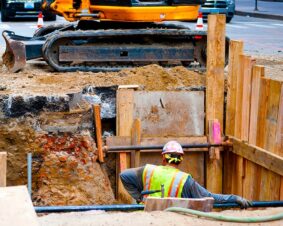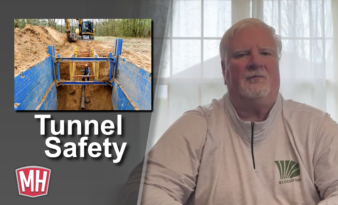Four years ago – what then was thought to be the upward climb in energy prices – Lancaster, PA-based news channels turned their viewing audience’s attention to geothermal technology. The information didn’t fall on deaf ears.
“I was amazed at how sensibly and efficiently thermal energy was transferred to and from the ground loops when these systems were used,” said one homeowner. Many families decided to take a closer look at the systems, wondering if they might have an energy “gold mine” in their own back yard.
While researching the geothermal technology, some buyers found one of Central Pennsylvania’s geothermal early adopters, Vince Youndt, president of Stevens, PA-based Vertex Mechanical, Inc.
Yet, with its rolling hills and a picturesque countryside, Pennsylvania's Dutch Country in Lancaster County is home to roughly 26,000 Amish people. Their aversion to new technology, especially the use of grid electricity, is testament to how they prefer to keep life simple; religion, family and farming being priority.
Deep within the heart of Amish country, nestled on a back country road is a beautiful farm with a centuries-old, hand-pressed brick home and chiseled limestone bank barn. At first glance, the only thing differentiates this property from an Amish home, is a visible electric line running along the driveway. 
Advancements on the home front
“This farm is our legacy,” the homeowner explained. “Our family acquired it in the 1930s. It’s our goal to be the best possible stewards of this property so that we can continue to hand it down through the generations.” Until recently, the property was an operating dairy farm. Now the crop land is rented to the Amish neighbor.
Built in the 1780s, with a large summer kitchen addition added in 1833, the structure totals about 3,000 square-feet. The old home’s existing system consisted of a 150 MBH oil-fired boiler, which remains as backup. Air conditioning was non-existent. But Vertex had a plan to shrink the heating bill and cool the space in the middle of Pennsylvania’s humid summers.
A five-ton, TTS ClimateMaster water-to-air geothermal split system now heats and cools the entire home, centrally. During the summer months, instead of relying on window units to make the home and bedrooms “just barely tolerable and somewhat less humid,” quipped Youndt, home comfort is improved every day of the year.
“There used to be only one thermostat in the entire house,” he added. “So, especially during the spring and fall, the rooms with southern exposure would be sweltering, while those on the North side were chilly. Fortunately, all of that is now a thing of the past.”
Walkin’ th’ walk
“We specialize in mechanical systems for historical homes and buildings,” explained Youndt. “With so many older, well-preserved buildings and homes in the area, we’ve found that many contractors lack the ability and skills to modernize them mechanically – so it’s become a passion of ours and a way to differentiate ourselves somewhat.”
Vertex’s own shop is an old brick, five-story tobacco warehouse, renovated and equipped with a ClimateMaster geothermal system. “We practice what we preach,” he added. “You can do almost anything with the variety of systems offered today: forced air, hydronics, radiant, domestic hot water, integration with solar and more.”
Based in the heart of Amish country, Vertex Mechanical specializes in heating and cooling systems for new installations, as well as upgrading, replacing and servicing existing systems, both residential and commercial. They pride themselves on quality and professional workmanship while aiming for the highest customer satisfaction, a goal that’s verified annually with exceptionally high customer service ratings, published in regional magazines.
According to Youndt, the older the home, the better. One source of pride is hiding ductwork where ductwork “can’t” be hidden, and installing state of the art mechanical systems in 150-year-old homes.
“Sometimes the homeowners are adamant about retaining the historical look, feel and aesthetics of their homes, to the point of hiding all facets of our work, even insulating to muffle any sound that mechanical systems may generate,” said Youndt. “With the geothermal systems we install, that’s not an issue.”
Split system and unique domestic supplyLike many of the old buildings Vertex crews have retrofitted, this home had no existing ductwork. Along with thick brick and stone (foundation) walls and horsehair plaster, installing the central system’s air handler was a bit challenging, but Vertex rose to the challenge.
The compressor unit for the house is located in the basement, with refrigerant lines that run to a 2,000 CFM attic air handler. The indoor portion of the installation took only two days to complete.
The split system is not a rare remedy to the ‘old house’ challenge, being that refrigerant lines are far easier to conceal than ductwork is. But, the ground-source installation at the home does have one very unique feature.
The TTS 064 five-ton ClimateMaster unit is equipped with a desuperheater, supplying hot water, and acting as an additional heat sink when in air conditioning mode. It’s how the desuperheater is connected to the water heater that is so interesting.
“Usually, a geo unit is connected directly to a water heater, pulling water from it, and dumping back into it. That’s not the case with any of the desuperheaters we install,” said Youndt. 
A typical Vertex installation includes two tanks. A 50-gallon Bradford White indirect tank is set between the geothermal unit and a 50-gallon electric water heater. Ground water comes into the indirect tank only, which the desuperheater begins to heat. The electric Bradford White unit draws heated domestic water from the indirect tank.
This configuration allows for much higher ΔT for the water heated by the geothermal system, decreasing the load on the ground loop. It also lowers the ΔT for the electric water heater. Additionally, there’s the added benefit of having more hot water on tap.
“ClimateMaster lists the double tank method as one of the recommended configurations,” said Youndt. “It works very well, though I’ve rarely seen anyone else use it quite the way we do.”
Exchange field
The farm is situated on 60 acres, so placing the well field was simple. Meyers Bros. drilling, out of Salunga, PA drilled the exchange field. Two, eight inch bore holes go to 375 feet each. A manifold is located at the top of the well heads, meaning there are only two penetrations in the home’s foundation, as opposed to four.
After the one-and-a-quarter inch U-bend loops were installed, the boreholes were backfilled with bentonite grout and stone dust for optimal heat transfer.
“I cannot say enough about the installation team,” said the homeowner. “They were respectful of our property and family, and their work ethic was second to none. There was no existing ductwork in our home, and they were able to use nooks and crannies to hide the ductwork without disturbing the look of our house. They worked around our three young sons and cleaned up as they went.”
Since Vertex installed the new system, the owners have been working on updating the house. Energy efficient windows were installed as well as weather stripping and many tubes of caulk.
Before the geo installation, the home used $5,000 worth of oil each winter, and almost another $1,000 for electric. The oil boiler is still used to supplement heat on the very coldest days, so the total heating bill is around $2,000 each winter. “The investment has definitely been worth it, especially considering that the farm will always be in the family,” said the homeowner.




Join the conversation: